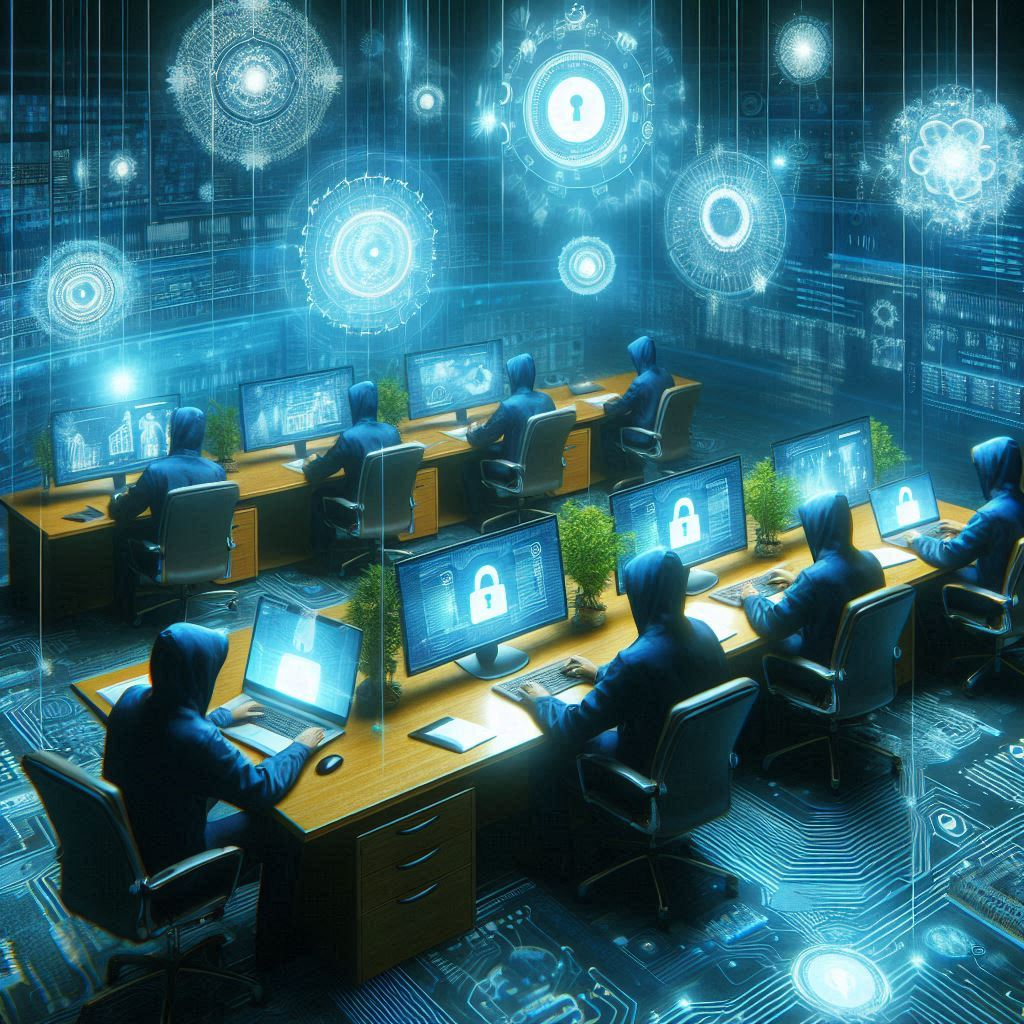and the distribution of digital products.
DM Television
How to Handle Ransomware if You Are a Worldwide Multi-Platform Large-Scale Enterprise?
\ We are talking about large-scale enterprises here.
\ Suppose you are a large-scale enterprise with centers on multiple continents.
\ How do you handle ransomware attacks?
\ Well, you’ll be giving them a lot more importance!
\ But suppose you are in a single country.
\ Not in the class of MAANG -
\ But still, a large-scale enterprise is operating 10-500 offices.
\ With heterogeneous systems.
\ How do you handle ransomware?
\ Let’s find out!
\
Best Practices to Handle Ransomware for Enterprises at Scale
Regular Backups: Schedule automated backups of critical data at regular intervals (daily, weekly) to ensure data is consistently saved and up-to-date.
\
Immutable Storage: Use storage solutions that provide immutability, meaning once data is written, it cannot be altered or deleted, protecting backups from ransomware encryption.
\
Multiple Locations: Store backups in diverse locations, including on-premises, offsite, and in the cloud, to safeguard against physical disasters and cyber threats.
\
Backup Testing: Regularly test the restoration process to verify that backups are functional and that data can be restored quickly in the event of an attack.
\
Encryption: Encrypt backup data both at rest and in transit to protect it from unauthorized access and ensure data integrity.
\
Advanced Endpoint Protection1. Endpoint Detection and Response (EDR): Deploy EDR solutions that monitor endpoint activities for suspicious behavior and provide real-time alerts for potential threats.
\ 2. Behavioral Analysis: Utilize machine learning algorithms to analyze user behavior and detect anomalies that may indicate a ransomware attack.
\ 3. Automated Threat Mitigation: Implement automated responses to detected threats, such as isolating affected endpoints or blocking malicious processes.
\ 4. Patch Management: Establish a patch management process to ensure all endpoint devices receive timely updates for operating systems and applications.
\ 5. Device Control: Limit the use of external devices (e.g., USB drives) and enforce policies to prevent unauthorized devices from connecting to the network.
\
Multi-Factor Authentication (MFA)Comprehensive Implementation: Apply MFA to all access points, including email, cloud services, and internal systems, to enhance security against unauthorized access.
\
User Education: Provide training on the importance of MFA and how to use it effectively, ensuring employees understand its role in protecting sensitive information.
\
Adaptive MFA: Utilize adaptive MFA solutions that assess risk factors (e.g., location, device) to determine when additional authentication is necessary.
\
Backup Authentication Methods: Offer alternative authentication methods (e.g., SMS, authenticator apps) in case primary methods fail, ensuring accessibility without compromising security.
\
Regular Review: Periodically review and update MFA policies to adapt to new threats and ensure compliance with best practices.
\
Network SegmentationLogical Segmentation: Divide the network into segments based on function, geography, or data sensitivity to limit the lateral movement of ransomware within the network.
\
Access Controls: Implement strict access controls between segments, ensuring that only authorized users and devices can communicate across network boundaries.
\
Micro-Segmentation: Consider micro-segmentation for critical applications and data, allowing for granular control over traffic flows and reducing the attack surface.
\
Monitoring Traffic: Continuously monitor traffic between segments for unusual patterns that may indicate an ongoing attack or breach.
\
Regular Audits: Conduct regular audits of network segmentation and access controls to identify and remediate any vulnerabilities.
Continuous Monitoring and Threat DetectionReal-Time Monitoring: Implement continuous monitoring solutions that provide real-time visibility into network activities and endpoint behaviors.
\
Automated Alerts: Set up automated alerts for suspicious activities, such as unusual file access patterns or unauthorized access attempts.
\
Threat Intelligence Integration: Leverage threat intelligence feeds to stay informed about emerging ransomware threats and adjust defenses accordingly.
\
Security Information and Event Management (SIEM): Use SIEM solutions to aggregate and analyze security data from across the enterprise, enabling faster detection and response to threats.
\
Incident Simulation: Regularly conduct incident simulations and tabletop exercises to test the effectiveness of monitoring systems and response plans.
\
Security Awareness TrainingRegular Training Sessions: Conduct ongoing training sessions to keep employees informed about the latest ransomware tactics and how to recognize phishing attempts.
\
Phishing Simulations: Implement simulated phishing attacks to test employees’ ability to identify and respond to potential threats, reinforcing training.
\
Clear Reporting Procedures: Establish clear procedures for reporting suspicious emails or activities, encouraging employees to act quickly.
\
Gamification: Use gamification techniques to make training engaging and rewarding, increasing participation and retention of information.
\
Management Involvement: Involve management in training initiatives to emphasize the importance of cybersecurity and foster a culture of security awareness.
\
Regular Software UpdatesAutomated Updates: Enable automated updates for software and operating systems to ensure timely application of security patches and reduce the risk of exploitation.
\
Inventory Management: Maintain an inventory of all software and systems in use, ensuring that all components are accounted for and regularly updated.
\
Vulnerability Scanning: Conduct regular vulnerability scans to identify outdated or unpatched software and prioritize remediation efforts.
\
Third-Party Software: Ensure that third-party applications are also kept up-to-date, as they can be entry points for ransomware attacks.
\
Compliance Checks: Regularly review compliance with software update policies to ensure adherence and identify areas for improvement.
\
Incident ResponsePlan Comprehensive Planning: Develop a detailed incident response plan that outlines roles, responsibilities, and procedures for responding to ransomware incidents.
\
Regular Testing: Conduct regular drills and tabletop exercises to test the effectiveness of the incident response plan and identify areas for improvement.
\
Communication Protocols: Establish clear communication protocols for internal and external stakeholders during an incident, including law enforcement and legal teams.
\
Post-Incident Review: After an incident, conduct a thorough review to analyze what occurred, evaluate the response, and implement lessons learned.
\
Continuous Improvement: Regularly update the incident response plan based on new threats, organizational changes, and lessons learned from past incidents.
\
Email and Web SecurityAdvanced Email Filtering: Implement email filtering solutions that use machine learning to identify and block malicious attachments and phishing attempts.
\
Web Filtering: Use web filtering technologies to block access to known malicious sites and prevent drive-by downloads that can lead to ransomware infections.
\
URL Scanning: Automatically scan URLs in emails and web traffic for potential threats before users access them.
\
Sandboxing: Employ sandboxing techniques to open email attachments and links in a secure environment, isolating potential threats from the main network.
\
User Policies: Establish clear policies regarding acceptable use of email and web resources, reinforcing the importance of security.
\
Proper IT HygieneStrong Password Policies: Enforce strong password policies that require complex passwords and regular changes to reduce the risk of credential theft.
\
Regular System Audits: Conduct regular audits of systems and networks to identify and remediate vulnerabilities, ensuring compliance with security policies.
\
Antivirus and Anti-Malware Solutions: Deploy up-to-date antivirus and anti-malware solutions across all devices to detect and block known threats.
\
Device Management: Implement mobile device management (MDM) solutions to secure and manage devices used for work, especially in remote work scenarios.
\
Physical Security Measures: Ensure physical security measures are in place to protect critical infrastructure and data centers from unauthorized access.
\
All That is a Lot of Work. Who Will Do All This?
\ Well, if you are a MAANG company, you already know the answer.
\ The time has come for a new department in every single large-scale enterprise.
\ Bid a grand welcome to your cybersecurity department and the CISO!
\
Why Every Large-Scale Enterprise Needs a 24/7/365 Security Department in Action\ This is an absolute must.
\ There are no workarounds and no excuses for not having a cybersecurity department.
\ All the work above cannot be done for the entire enterprise for every department.
\ There has to be a central cybersecurity department handling every single one of the measures listed above, especially the cloud backups.
\ SMB enterprises do not have the funds.
\ Large-scale enterprises do.
\ If you value your business, invest in a Cybersecurity department immediately (if you don’t already have one).
\ This single step (which is not simple by any means) could save you billions in the future.
\ So what will the Cybersecurity department be responsible for, and how do you hire them?
\ Let’s Find Out!
\
Creating a Cybersecurity Department
\
Chief Information Security Officer (CISO)
\
Leadership: Oversee the entire cybersecurity strategy and ensure alignment with business objectives.
Policy Development: Develop and enforce security policies and procedures.
Risk Management: Conduct risk assessments to identify vulnerabilities and threats.
Budget Management: Allocate resources for cybersecurity initiatives and manage the budget.
Stakeholder Communication: Report to executive leadership and communicate security posture to stakeholders.
\
Security Analyst
\
Monitoring: Continuously monitor network traffic and systems for suspicious activity.
Incident Response: Respond to security incidents and breaches, conducting investigations and remediation.
Threat Intelligence: Stay updated on the latest threats and vulnerabilities affecting the organization.
Reporting: Produce reports on security incidents and recommend improvements.
Compliance: Ensure adherence to regulatory requirements and internal policies.
\
Security Engineer
\
System Design: Design and implement secure network architectures and security controls.
Tool Management: Manage security tools and technologies, such as firewalls, IDS/IPS, and antivirus solutions.
Vulnerability Assessment: Conduct regular vulnerability assessments and penetration testing.
Configuration Management: Ensure secure configurations of systems and applications.
Documentation: Maintain documentation for security processes and configurations.
\
Incident Response Specialist
\
Incident Handling: Lead the response to security incidents, coordinating with internal teams and external partners.
Forensics: Conduct forensic analysis to determine the cause and impact of incidents.
Recovery Planning: Develop and implement recovery plans to restore services post-incident.
Training: Train staff on incident response procedures and best practices.
Post-Incident Review: Conduct reviews after incidents to identify lessons learned and improve processes.
\
Compliance Officer
\
Regulatory Oversight: Ensure the organization complies with relevant laws and regulations (e.g., GDPR, HIPAA).
Policy Development: Develop compliance policies and procedures.
Auditing: Conduct regular audits to assess compliance with security policies.
Training: Provide training to employees on compliance requirements.
Reporting: Report compliance status to executive management and recommend improvements.
\

Conduct a Comprehensive Risk Assessment
Identify critical assets, potential threats, and vulnerabilities.
Evaluate the potential impact of a ransomware attack on business operations.
\
Develop a Cybersecurity Strategy
Create a high-level strategy that outlines goals, objectives, and key initiatives for the cybersecurity program.
Align the strategy with business objectives and regulatory requirements.
\
Implement Strong Access Controls
Enforce the principle of least privilege, ensuring users have only the access necessary for their roles.
Utilize multi-factor authentication (MFA) for all critical systems and applications.
\
Establish a Security Awareness Training Program
Provide regular training sessions for all employees to raise awareness about cybersecurity threats and best practices.
Use simulations and interactive training to engage employees and reinforce learning.
\
Deploy Endpoint Protection Solutions
Implement advanced endpoint protection tools that include antivirus, anti-malware, and intrusion detection capabilities.
Ensure regular updates and patch management for all systems and applications.
\
Create an Incident Response Plan
Develop a detailed incident response plan that outlines procedures for detecting, responding to, and recovering from security incidents.
Conduct regular drills and tabletop exercises to test the plan and improve readiness.
\
Establish Monitoring and Logging Practices
Implement continuous monitoring of network traffic and system logs to detect anomalies and potential threats.
Use Security Information and Event Management (SIEM) tools to aggregate and analyze security data.
\
Regularly Update and Patch Systems
Establish a routine for updating software and systems to address known vulnerabilities.
Automate patch management processes where feasible to ensure timely updates.
\
Backup Critical Data Regularly
Implement a robust backup strategy that includes regular backups of critical data and systems.
Store backups in secure, offsite locations to protect against ransomware attacks.
\
Foster a Culture of Security
Promote a culture of security throughout the organization, encouraging all employees to take responsibility for protecting sensitive information.
Recognize and reward employees who demonstrate good cybersecurity practices.
\
This is a massive undertaking and requires a massive retraining and restructuring of the entire enterprise.
\ Wouldn’t it be wonderful if you could just outsource all the work to an external team of experts?
\ As it turns out, you can.
\ Here are the top 10 cybersecurity firms that deal with large-scale enterprises, especially for ransomware and cybersecurity.
\ Check them all out, make a detailed investigation, and choose the one that seems the best!
\
Top 10 CyberSecurity Firms that Cater to Large Enterprises
Here is a list of 10 top cybersecurity firms that cater to large enterprises.
\
Palo Alto NetworksOverview:
Founded in 2005, Palo Alto Networks has established itself as a leader in cybersecurity solutions. The company offers a comprehensive suite of products, including next-generation firewalls, endpoint protection, and cloud security.
Their solutions are designed to prevent cyber threats by integrating advanced machine learning and threat intelligence capabilities, making them a go-to choice for many large organizations.
Key Selling Point:
Palo Alto Networks is renowned for its innovative approach to security, particularly its ability to provide a unified security platform that integrates various security functions into a single solution.
This allows organizations to manage their security posture more effectively and respond to threats in real-time.
Pros:
Comprehensive security portfolio that covers multiple aspects of cybersecurity.
Strong threat intelligence capabilities through its Unit 42 team, which actively researches and reports on emerging threats.
High performance in independent security tests, consistently ranking as a top provider.
Cons: The cost can be prohibitive for smaller organizations, making it more suitable for larger enterprises. Some users report a steep learning curve when implementing and managing their solutions.
\
FortinetOverview: Fortinet, established in 2000, provides a wide range of security solutions, including firewalls, intrusion prevention systems, and endpoint security. Known for its high-performance security appliances, Fortinet serves thousands of organizations worldwide, including many large enterprises. Their FortiGate firewalls are particularly notable for their speed and effectiveness. Key Selling Point: Fortinet's Security Fabric architecture enables organizations to deploy a comprehensive security strategy across their entire network, providing visibility and control over all assets. This integrated approach simplifies security management and enhances overall effectiveness. Pros: Strong performance and scalability, making it suitable for large enterprises. Comprehensive threat intelligence capabilities through FortiGuard Labs. Cost-effective solutions for network security.
Cons: Complexity in deployment and management can be a challenge for some organizations. Some users report that the user interface could be more intuitive.
IBM SecurityOverview: IBM Security offers a comprehensive suite of cybersecurity solutions, including threat intelligence, incident response, and identity management. With a long-standing reputation in technology and security, IBM provides organizations with advanced analytics and AI-driven insights to enhance their security posture. Their solutions are widely used in various sectors, including healthcare, finance, and government. Key Selling Point: IBM's Watson for Cyber Security leverages artificial intelligence to analyze vast amounts of data and provide actionable insights, helping organizations detect and respond to threats more effectively. Pros: Extensive experience and a robust portfolio of security products. Strong analytics capabilities that enhance threat detection and response. Integration with existing IT infrastructure is often seamless.
Cons: The complexity of solutions can lead to longer implementation times. Some users find the pricing structure confusing and potentially high.
\
Cisco SecurityOverview: Cisco is a long-standing leader in networking and cybersecurity, offering a wide range of security solutions including firewalls, VPNs, and endpoint protection. The company's security products are designed to protect against a variety of threats while integrating seamlessly with its networking solutions. Cisco's security solutions are widely used in enterprise environments, providing robust protection across multiple layers. Key Selling Point: Cisco's Security Cloud provides a unified approach to security, enabling organizations to manage their security posture across all environments—on-premises, cloud, and hybrid—through a single platform. Pros: Comprehensive security solutions that cover multiple aspects of cybersecurity. Strong integration capabilities with existing Cisco networking products. High level of customer support and professional services.
Cons: Initial setup can be complex and time-consuming. Some features may require additional licensing, increasing overall costs. 5
\
Check Point Software TechnologiesOverview: Check Point is a pioneer in cybersecurity, known for its advanced firewall and VPN solutions. Founded in 1993, the company offers a comprehensive suite of security products designed to protect networks, endpoints, and cloud environments from a wide range of threats. Check Point's focus on threat prevention and integrated security solutions has made it a trusted partner for many large organizations. Key Selling Point: Check Point's Infinity Architecture provides a consolidated security approach, integrating threat prevention across all attack surfaces, including networks, cloud, mobile, and IoT devices. Pros: Strong performance in threat detection and prevention. User-friendly management interface that simplifies security operations. Robust reporting and analytics capabilities.
Cons: Licensing can be complex, with multiple options that may confuse users. Some users report that customer support can be slow to respond.
\
Trend MicroOverview:
Trend Micro is a global cybersecurity leader providing a range of solutions, including endpoint security, cloud security, and network defense. Founded in 1988, the company has a strong focus on protecting against ransomware and other advanced threats. Trend Micro's solutions are designed to safeguard sensitive data and ensure compliance with industry regulations.
Key Selling Point:
Trend Micro's XGen security combines multiple techniques—signature-based, behavioral, and machine learning—to provide comprehensive protection against a wide range of threats.
Pros:
Effective malware protection with high detection rates. Good integration with existing systems and cloud environments. Strong focus on data protection and compliance.
Cons: Some users report a learning curve with the interface and configuration. The breadth of features can lead to complexity in management.
\
FireEyeOverview: FireEye is known for its advanced threat intelligence and incident response services. Founded in 2004, the company provides a range of security solutions designed to protect organizations from sophisticated cyber threats. FireEye's Mandiant services are particularly notable for their effectiveness in incident response and threat hunting. Key Selling Point: FireEye's Mandiant services offer expert incident response and threat intelligence, helping organizations to quickly identify and mitigate threats. Pros: Strong incident response capabilities with a team of experienced professionals. Comprehensive threat intelligence that enhances security posture. Effective at detecting and responding to advanced persistent threats.
Cons: Solutions can be expensive, particularly for smaller organizations. Some users find the user interface less intuitive compared to competitors.
\
ZscalerOverview: Zscaler is a cloud-based security provider that focuses on secure access and threat protection for organizations. Founded in 2008, Zscaler offers a zero-trust security model that enables secure connections to applications regardless of user location. Their solutions are particularly well-suited for organizations with a distributed workforce. Key Selling Point: Zscaler's cloud-native architecture allows organizations to implement a zero-trust model effectively, ensuring that all users are authenticated and authorized before accessing applications. Pros: Scalable solutions that are ideal for remote workforces and distributed environments. Strong focus on data protection and compliance. User-friendly interface that simplifies management.
Cons: Requires a shift in how organizations approach security, which may require adjustment. Pricing options are not publicly available and typically require consultation.
\
McAfee EnterpriseOverview: McAfee Enterprise provides a range of security solutions, including endpoint protection, cloud security, and data protection. The company has a long history in cybersecurity and offers a comprehensive suite of products designed to protect organizations from various threats. McAfee's focus on data protection and compliance makes it a popular choice for many enterprises. Key Selling Point: McAfee's integrated security platform allows organizations to manage their security posture across multiple environments, providing visibility and control over all assets. Pros: Comprehensive security solutions that cover multiple aspects of cybersecurity. Strong focus on data protection and compliance. Good integration capabilities with existing systems.
Cons: Some users report that the interface can be cumbersome and less intuitive. Ongoing subscription costs can add up, particularly for larger deployments.
\
KasperskyOverview: Kaspersky offers a range of cybersecurity solutions, including endpoint protection and threat intelligence. Founded in 1997, Kaspersky is known for its strong malware detection capabilities and proactive threat intelligence. The company serves a diverse range of industries, including healthcare, finance, and government. Key Selling Point: Kaspersky's solutions are designed to protect against a wide range of threats, including ransomware, advanced persistent threats, and targeted attacks. Their proactive approach to threat intelligence is a significant advantage. Pros: High detection rates and effective protection against malware. Strong focus on threat intelligence and proactive defense. User-friendly interface that simplifies management.
Cons: Some concerns regarding data privacy due to Russian ownership. Limited features in some lower-tier products.
\

I hope that helps.
\ As a large-scale enterprise, you are highly vulnerable.
\ It is not easy to secure every point of access when you employ thousands of employees.
\ My recommendation is: go for the external firms if your budget can afford it.
\ Otherwise - train your own group, in station.
\ It often helps to have your own people retrained in cybersecurity by external training firms.
\ And those exist too!
\ Outsourcing could cost 50,000 USD a month.
\ But if you have the money, it could be the best investment of your entire enterprise.
\ All the best!
\

- https://www.veeam.com/blog/enterprise-ransomware-protection.html
- https://spin.ai/blog/how-to-choose-the-right-enterprise-ransomware-protection-solution-for-your-business/
- https://surelocktechnology.com/blog/enterprise-ransomware-protection
- https://www.cisecurity.org/insights/blog/7-steps-to-help-prevent-limit-the-impact-of-ransomware
- https://www.digitalguardian.com/blog/ransomware-protection-best-practices-tips-and-solutions
- https://www.netguru.com/blog/cybersecurity-plan-enterprise
- https://www.quatrrobss.com/articles-blogs/5-key-steps-to-building-a-proactive-cybersecurity-strategy-for-large-enterprises/
- https://nordlayer.com/blog/cyber-security-for-enterprise-guide/
- https://www.reddit.com/r/cybersecurity/comments/plmc2h/how_can_i_start_a_cybersecurity_department_from/
- https://www.insureon.com/blog/how-to-get-into-the-cybersecurity-industry
- https://www.checkpoint.com/cyber-hub/cyber-security/what-is-enterprise-cybersecurity/
- https://techreviewer.co/top-cybersecurity-companies
- https://www.esecurityplanet.com/products/top-cybersecurity-companies/
- https://www.n-ix.com/cybersecurity-consulting-firms/
- https://cybermagazine.com/articles/top-10-cyber-solutions-to-protect-your-business
\ \
- Home
- About Us
- Write For Us / Submit Content
- Advertising And Affiliates
- Feeds And Syndication
- Contact Us
- Login
- Privacy
All Rights Reserved. Copyright , Central Coast Communications, Inc.